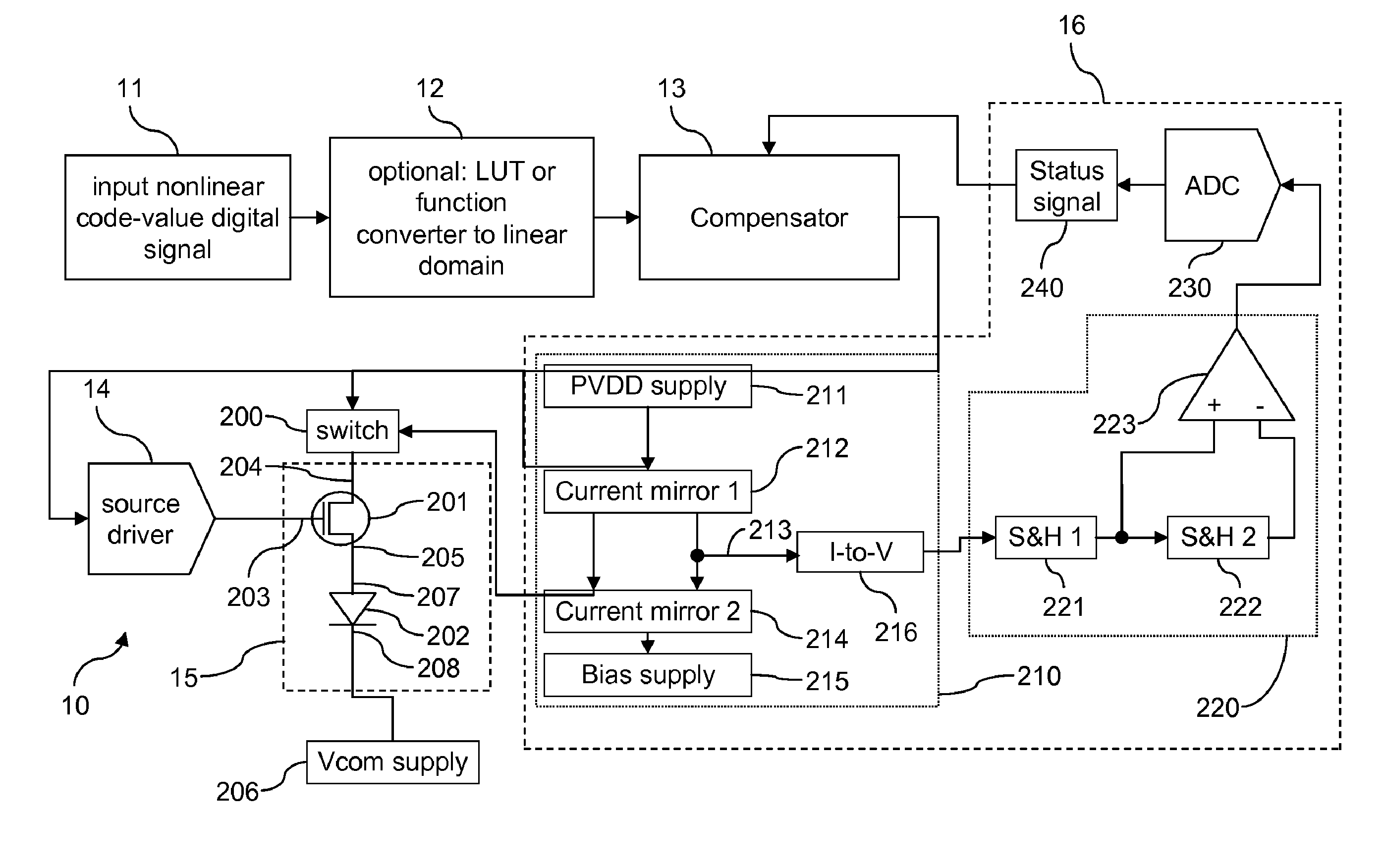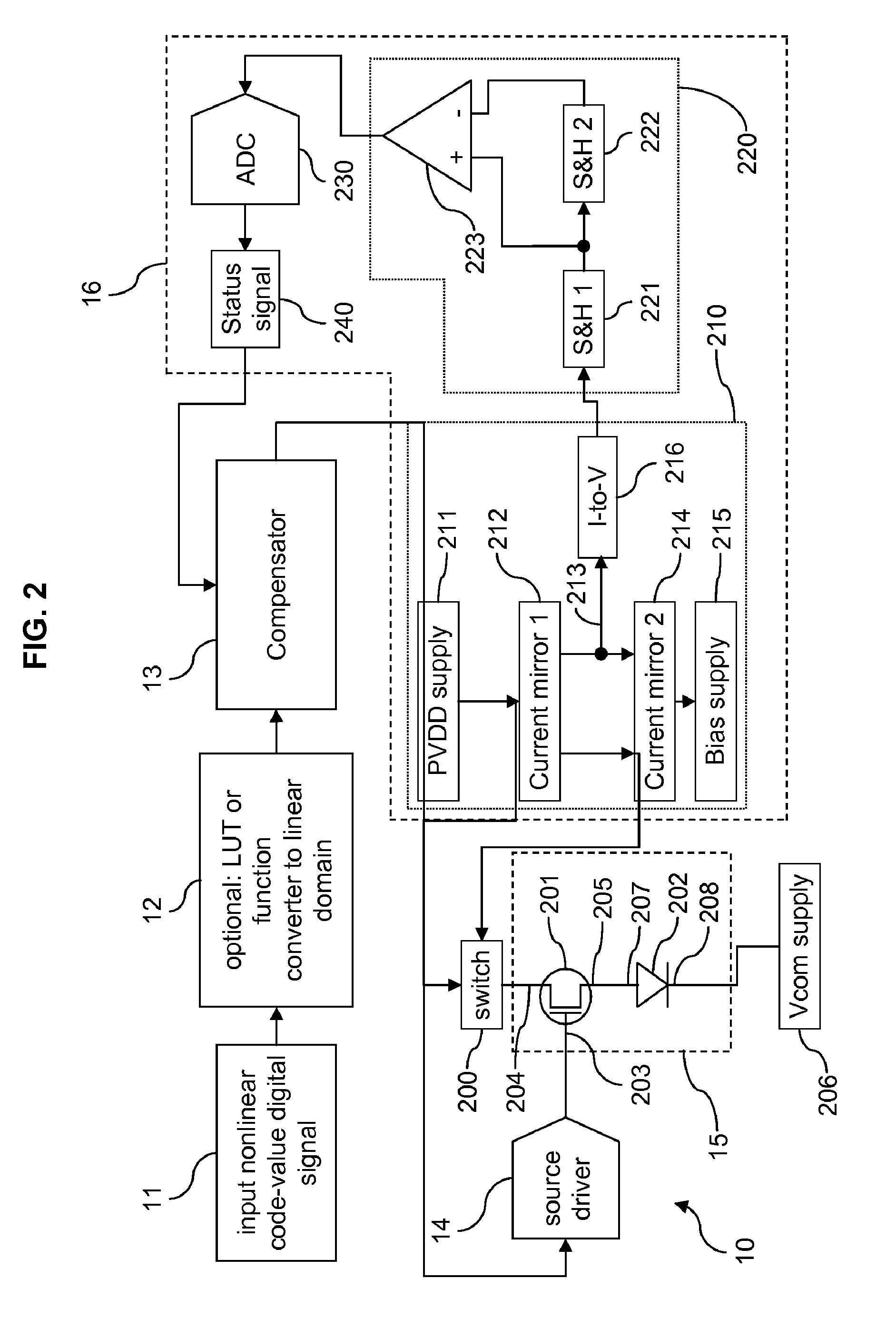Electroluminescent display compensated drive signal
a technology of electric display and drive signal, applied in the field of electric display compensation drive signal, can solve the problems of increasing the electronics size of the subpixel, increasing the complexity of the subpixel, and unable to compensate for the rise or fall of vsub>oled efficiency loss, so as to reduce the aperture ratio of the subpixel, simplify the compensation of the control signal, and reduce the effect of oled efficiency loss
- Summary
- Abstract
- Description
- Claims
- Application Information
AI Technical Summary
Benefits of technology
Problems solved by technology
Method used
Image
Examples
first embodiment
[0081]In the present invention, each current difference, e.g. 43, can be the status signal for a corresponding subpixel. For example, current difference 43 can be the status signal for the subpixel attached to row line 34b and column line 32a. In this embodiment the status signal generation unit 240 can perform a linear transform on current differences, or pass them through unmodified. All subpixels can be measured at the same measurement reference gate voltage, so that the current (43) through each subpixel at the measurement reference gate voltage meaningfully represents the characteristics of the drive transistor and EL emitter in that subpixel. The current differences 43 can be stored in memory 619.
second embodiment
[0082]In a second embodiment, memory 619 stores a respective target signal i0 611 for each EL subpixel. Memory 619 also stores a most recent current measurement i1 612 of each EL subpixel, which can be the value most recently measured by the measurement circuit for the corresponding subpixel. Measurement 612 can also be an average of a number of measurements, an exponentially-weighted moving average of measurements over time, or the result of other smoothing methods which will be obvious to those skilled in the art. Target signal i0 611 and current measurement i1 612 can be compared as described below to provide a percent current 613, which can be the status signal for the EL subpixel. The target signal for a subpixel can be a current measurement of that subpixel taken at a different time than measurement i1 612, preferably before i1, and thus percent current can represent variations in the characteristics of the respective drive transistor and EL emitter caused by operation of the ...
third embodiment
[0083]In a third embodiment, memory 619 stores a mura-compensation gain term mg 615, and a mura-compensation offset term mo 616, calculated as described below. The status signal for each EL subpixel can include a respective gain and offset, and specifically respective mg and mo values. Values mg and mo are computed with respect to a target and thus represent variations in the characteristics of the respective drive transistors and EL emitters across multiple subpixels. Additionally, any (mg, mo) pair by itself represents the characteristics of the drive transistor and EL emitter in the respective subpixel.
[0084]These three embodiments can be used together. For example, the status signal for each subpixel can include percent current, mg and mo. Compensation, described below in “Implementation,” can be performed in the same way whether the status signal indicates variations for a single subpixel over time (aging) or variations across multiple subpixels at a particular time (mura). Mem...
PUM
 Login to View More
Login to View More Abstract
Description
Claims
Application Information
 Login to View More
Login to View More - R&D
- Intellectual Property
- Life Sciences
- Materials
- Tech Scout
- Unparalleled Data Quality
- Higher Quality Content
- 60% Fewer Hallucinations
Browse by: Latest US Patents, China's latest patents, Technical Efficacy Thesaurus, Application Domain, Technology Topic, Popular Technical Reports.
© 2025 PatSnap. All rights reserved.Legal|Privacy policy|Modern Slavery Act Transparency Statement|Sitemap|About US| Contact US: help@patsnap.com



